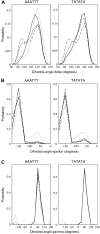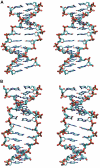Minor groove deformability of DNA: a molecular dynamics free energy simulation study
- PMID: 16698780
- PMCID: PMC1563752
- DOI: 10.1529/biophysj.106.083816
Minor groove deformability of DNA: a molecular dynamics free energy simulation study
Abstract
The conformational deformability of nucleic acids can influence their function and recognition by proteins. A class of DNA binding proteins including the TATA box binding protein binds to the DNA minor groove, resulting in an opening of the minor groove and DNA bending toward the major groove. Explicit solvent molecular dynamics simulations in combination with the umbrella sampling approach have been performed to investigate the molecular mechanism of DNA minor groove deformations and the indirect energetic contribution to protein binding. As a reaction coordinate, the distance between backbone segments on opposite strands was used. The resulting deformed structures showed close agreement with experimental DNA structures in complex with minor groove-binding proteins. The calculated free energy of minor groove deformation was approximately 4-6 kcal mol(-1) in the case of a central TATATA sequence. A smaller equilibrium minor groove width and more restricted minor groove mobility was found for the central AAATTT and also a significantly ( approximately 2 times) larger free energy change for opening the minor groove. The helical parameter analysis of trajectories indicates that an easier partial unstacking of a central TA versus AT basepair step is a likely reason for the larger groove flexibility of the central TATATA case.
Figures










Similar articles
-
Conformational transitions in RNA single uridine and adenosine bulge structures: a molecular dynamics free energy simulation study.Biophys J. 2006 Apr 1;90(7):2450-62. doi: 10.1529/biophysj.105.076158. Epub 2006 Jan 6. Biophys J. 2006. PMID: 16399833 Free PMC article.
-
Does TATA matter? A structural exploration of the selectivity determinants in its complexes with TATA box-binding protein.Biophys J. 1997 Aug;73(2):640-52. doi: 10.1016/S0006-3495(97)78099-8. Biophys J. 1997. PMID: 9251783 Free PMC article.
-
DNA structure: what's in charge?J Mol Biol. 2000 Dec 15;304(5):803-20. doi: 10.1006/jmbi.2000.4167. J Mol Biol. 2000. PMID: 11124028
-
What drives proteins into the major or minor grooves of DNA?J Mol Biol. 2007 Jan 5;365(1):1-9. doi: 10.1016/j.jmb.2006.09.059. Epub 2006 Sep 27. J Mol Biol. 2007. PMID: 17055530 Free PMC article. Review.
-
DNA recognition by beta-sheets.Biopolymers. 1997;44(4):335-59. doi: 10.1002/(SICI)1097-0282(1997)44:4<335::AID-BIP3>3.0.CO;2-R. Biopolymers. 1997. PMID: 9782775 Review.
Cited by
-
Structural and energetic heterogeneities of canonical and oxidized central guanine triad of B-DNA telomeric fragments.J Mol Model. 2009 Jun;15(6):607-13. doi: 10.1007/s00894-008-0438-1. Epub 2009 Jan 9. J Mol Model. 2009. PMID: 19132417
-
Local and global effects of strong DNA bending induced during molecular dynamics simulations.Nucleic Acids Res. 2009 Jun;37(11):3766-73. doi: 10.1093/nar/gkp234. Epub 2009 Apr 20. Nucleic Acids Res. 2009. PMID: 19380377 Free PMC article.
-
Structural underpinnings of mutation rate variations in the human genome.Nucleic Acids Res. 2023 Aug 11;51(14):7184-7197. doi: 10.1093/nar/gkad551. Nucleic Acids Res. 2023. PMID: 37395403 Free PMC article.
-
Base flip in DNA studied by molecular dynamics simulationsof differently-oxidized forms of methyl-Cytosine.Int J Mol Sci. 2014 Jul 3;15(7):11799-816. doi: 10.3390/ijms150711799. Int J Mol Sci. 2014. PMID: 24995694 Free PMC article.
-
Integrating multi-scale data on homologous recombination into a new recognition mechanism based on simulations of the RecA-ssDNA/dsDNA structure.Nucleic Acids Res. 2015 Dec 2;43(21):10251-63. doi: 10.1093/nar/gkv883. Epub 2015 Sep 17. Nucleic Acids Res. 2015. PMID: 26384422 Free PMC article.
References
-
- Hagerman, P. J. 1990. Flexibility of DNA. Annu. Rev. Biochem. 59:755–781. - PubMed
-
- El Hassan, M. A., and C. R. Calladine. 1995. The assessment of the geometry of dinucleotide steps in double-helical DNA: a new local calculation scheme. J. Mol. Biol. 251:648–664. - PubMed
-
- Packer, M. J., M. P. Dauncey, and C. A. Hunter. 2000. Sequence-dependent DNA structure: tetranucleotide conformational maps. J. Mol. Biol. 295:85–103. - PubMed
-
- Rhodes, D., J. W. Schwabe, L. Chapman, and L. Fairall. 1996. Towards an understanding of protein-DNA recognition. Philos. Trans. R. Soc. Lond. B Biol. Sci. 351:501–509. - PubMed
Publication types
MeSH terms
Substances
LinkOut - more resources
Full Text Sources
Research Materials

